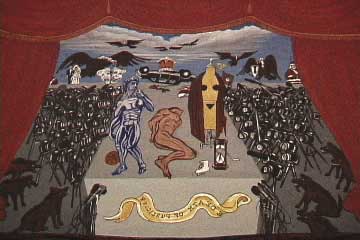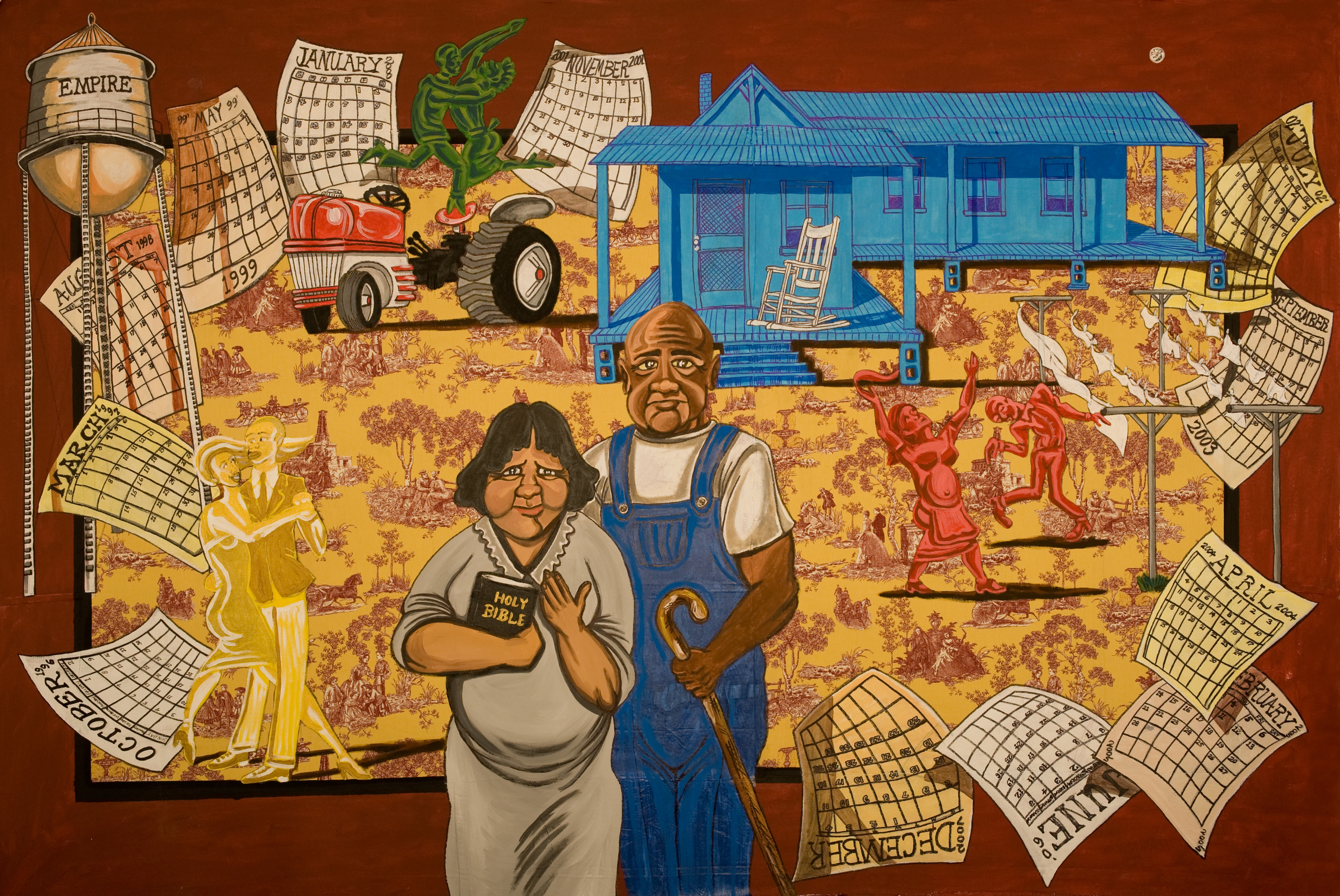Keith Duncan
Curated by Willie Birch
November 18, 2010 – January 15, 2011
Keith Duncan received a BFA from Louisiana State University, Baton Rouge, and an MFA in art education from City University of New York, Hunter College. His solo exhibitions include Taller Boricua Gallery and Gallery X, New York, NY; Independent Arts Gallery, Queens, NY; Danny Simmons' Corridor Gallery, Brooklyn, NY; and Artsproject Gallery, New Orleans, LA. Selected group exhibitions include Art in General, David Beitzel Gallery, Rush Arts Gallery, Studio Museum in Harlem, New York, NY; The Museum of Contemporary Art, Pontiac, MI; Bronx River Art Center & Gallery, Bronx, NY; and the Tustin Center, Philadelphia, PA. He was awarded the Camille Cosby Fellowship, The Joan Mitchell Foundation Grant, and in 2001 his work was commissioned for the National Aeronautics and Space Administration in Washington, D.C. Duncan's exhibition at CUE marks his first solo show in New York in over ten years.
Willie Birch was born in New Orleans in 1942. He received a BA from Southern University in New Orleans in 1969 and a MFA in art education from the Maryland Institute College of Art in Baltimore in 1973. After a brief incursion into abstraction, he began a long and honest search for his own personal voice, studying Western Art, African philosophy, the music of jazz and the legacy of African American artists. It will lead him back to his own roots, New Orleans and its complex heritage and culture, and to the tradition of the narrative.
In 1975 Birch moved to New York and began to develop the characteristic style for which he will become known; breaking down his formal training to create deceptively simple flat narrative surfaces, that draw as much from William H. Johnson's "primitive" style as from European and Latin American "naif" styles. In the early 80s he will arrive at the body of work for which he is most known, sculptures and paintings realized in colored papier-maché that portray the lives
of ordinary people, constitute comments on the political events of the time, or pay homage to African traditions. With his first National Endowment of the Arts Fellowship in 1984 (he would receive a second one in 1990) he made his first trip toAfrica, visiting Egypt. It is following his second visit to Africa in the early nineties, that he receives a Guggenheim Fellowship that will allow him to return to New Orleans. There he has become immersed and deeply invested in the community, particularly of the Seventh Ward neighborhood, where he continues to live.
Willie Birch's work is imbued with powerful political, sociological and spiritual meaning. His latest work, a series of large-scale paintings made in acrylic and charcoal on paper, documents and celebrates the people and spirit of New Orleans. Begun in color, and later done in a very distinctive black and white technique, these works capture the vibrant rituals and spirit of New Orleans in street parades, second lines and the revelry of Zulu but also the harshness, dignity, uniqueness and beauty of everyday life.
In 2005 Willie Birch was recipient of a fellowship at CUE Art Foundation, when he produced large-scale grisaille works on paper that were later shown at the Luise Ross Gallery in 2006. Apart from the National Endowment of the Arts Fellowships, and the Guggenheim Fellowship in 1993, he has received numerous awards and fellowships including the Mayor's Arts Award in New Orleans in 2002, the Governor's Award, State of Louisiana; a Joan Mitchell Foundation Grant in 2006 and the Benjamin Altman Prize of the National Academy of Design in 2008.
The work of Willie Birch is found in museum collections as well as public and private collections across the country, including the Metropolitan Museum of Art, the New Orleans Museum of Art and the Pennsylvania Academy of Fine Arts. A retrospective of his work, Celebrating Freedom: The Art of Willie Birch traveled the United States in 2006, culminating at the Contemporary Arts Center in New Orleans in 2008. Recent exhibitions include The Chemistry of Color, Contemporary African-American Artists at Columbia Museum of Art, Columbia, SC and The Global Africa Project at the Museum of Arts and Design in New York, as well as a solo exhibition at Arthur Roger Gallery, New Orleans.
ARTIST'S STATEMENT
Mark Twain wrote in his 1897 essay How to Tell a Story:
"... Story depends for its effect on the ‘manner' of the telling..."
The Storyteller is one who is constantly searching for his or her self. Furthermore, they need a public with which to identify. Through reading Art and Psychoanalysis and An Art of Our Own: The Spiritual in 20th Century Art, I have discovered some things. First, what artists think of and how they think is vital to the artists survival, process and growth in a creative sense. To analyze the world of an artist usually is a complex and exhaustible study. In each research the results are primal-oriented, stemming from childhood experiences and autobiographical development through self-analytical discovery. The primal is evident in each artist's work. The upbringing of an artist does have some affect on their work because belief systems can have a lasting influence on the artist's work. In my narrative and social-political symbolism, I have discovered psychological ties to my childhood and an array of relationship patterns and experiences, also with a combined style to past artists and their childhood biography. Metaphors and manifestations of mother-child relationships, and the oedipal stages have shaped my insight and experiences to a great degree.My style is a subject in imagery and its association to the subconscious mind.
Secondly, the spiritual identities in my artworks are combinations of poetic insights to motion and reflections on the human condition. In this vain, my art requires more investigation of my use of symbols, composition and content. Aesthetically, the richness of color gives the viewer an insight to the beauty my paintings generally evoke. The familiarity of the landscapes in my art at times is odd, sometimes awkward; something that does not fit, something blank, mysterious and undecipherable that draws the whole story in itself or to itself. Also, while prophesying my point in the same vein my paintings put the audience in an uncanny moment of seeking out more behind the "hidden" messages or symbols. The public may want to deeply investigate my thought pattern in terms of aesthetics and overall content.
The works in this series are discoveries and a creative process from the "autobiography becoming the iconography" and in search of seeing the image as a new invention or archetype. Much like an epic motion picture, my paintings attempt to bring about a dialogue in sensitivity which will evoke feelings of the spiritual at work. With symbols or symbiotic images, I want to produce a distinct language in narrative form that has literary, poetic, or narrative content. This is the basis of my surreal paintings - constantly searching for and needing the audience to identify with.
With titles like Rise of the South, I got my ‘Mo-Jo' back, and Requiem for a Nigga,my recent series of work focuses on a more autobiographical search for my past (i.e., childhood stories and cultural references to my region, the Deep South). This is my new environment, my new landscape and, like many great American painters and storytellers, I am obsessed with the notion of revealing the source, strength, and mysticism of the South.
CURATOR'S STATEMENT
by Willie Birch
Keith Duncan grew up on the west bank in Plaquemines Parish, Louisiana. The land of the staunch segregationist Leander Perez, a stone throw from the city of New Orleans. Growing up, Duncan heard many stories, particularly from his father, about Louisiana culture; Congo Square, Louis Armstrong, and the place of his birth, Charity Hospital, the now closed hospital of historical significance in the lives of so many New Orleanians, celebrities and politicians, living and dead.
Duncan is an original. He is a formally trained artist who studied at Louisiana State University in Baton Rouge and Hunter College in New York City, where he lived for many years. Early on Duncan learned how to use humor as a tool in tempering his viewer's reality. It allowed him to navigate his artistic expression through unpopular subjects. Duncan is a comedian, a trickster, a shaman that unflinchingly tells us in his paintings what he feels is important and what he wants his public to know.
Since returning home to Louisiana from New York in 2007, Duncan has created two substantial bodies of work. The first one is titled A Message to the Press, Surreal Paintings by Keith J. Duncan. This body of work chronicles New Orleans folk culture, based on those stories told by his father. The subject matter ranges from memories of hurricane Betsy, Camille and Katrina, to Barack Obama being elected President of the United States. These works are acrylic paintings on rectangular shaped birch-wood, approximately 48 by 48 inches, all executed in 2009. Here, the figures depicted have a cartoonish, flat quality, outlined with an expressive black line.
The new body of work is a continuation of the A Message to the Press series, but represents a great leap forward. These new works are approximately 8 by 6 feet. They are constructed of patterned textile fabric glued to clean cotton fabric, creating an appliqué sensibility as found in the African American patchwork quilting tradition. The flat, painterly figures in expressive black lines overlap patterned textile and cotton fabric, creating a rhythmic, improvisational, all over painterly sensibility.
Duncan's works are narrative, autobiographical, figurative, political and layered in personal symbolism and metaphors. His use of folklore speaks directly to his sense of place and history. With his understanding of form as language, Duncan is constantly in dialogue with his neighbors, as well as with the art-world. Through his mastery of process and content, he allows this dialogue to take place across class and race. Upon being asked if he had a particular audience he created for, Duncan replied that he creates for everyone.
I personally see Keith Duncan as an "Art Romantic"; he creates art that is spiritually and intellectually engaging. Until now, Duncan's work has for the most part been overlooked. He gets very little support in terms of being included in art shows or artist residency studio programs or sales. Although he constantly finds himself in financial hardship, he continues to create, believing in what he does as a calling. At this time, in our commercially driven society, artwork such as Duncan's is considered not sellable. It is reflective of an America that too many people want to deny. Duncan's reward is that his majority audience openly celebrates his efforts to chronicle their experiences.
The gatekeepers of High Art too often tend to reward artists less on content and more on technique, and I would say particularly artists of color. I see Duncan's work as a shadow that will not go away, that has all the visual references of the dominant art culture, yet reflects a world whose existence is not acknowledged. Unfortunately, artwork of this nature is for the most part given credibility long after its creation, if it does survive. The events of 9-11, Katrina, the election of Barack Obama and the Gulf Oil Spill have added a new meaning to art with content in America. With that said, Keith J. Duncan is an artist of his time. This new body of work is a testament to this moment.
View CATALOGUE
YOUNG ART CRITICS: Cameron Shaw on Keith Duncan




